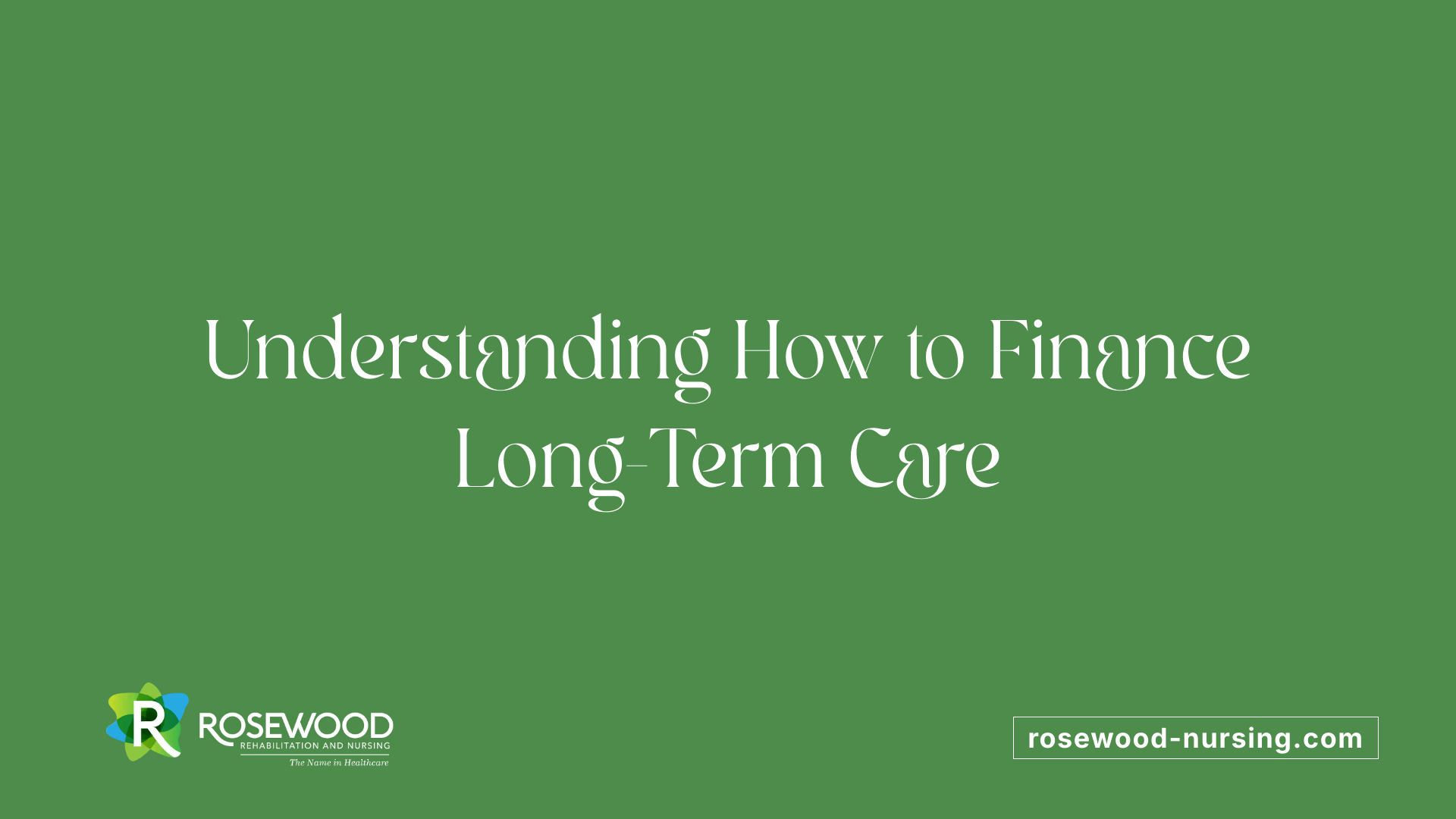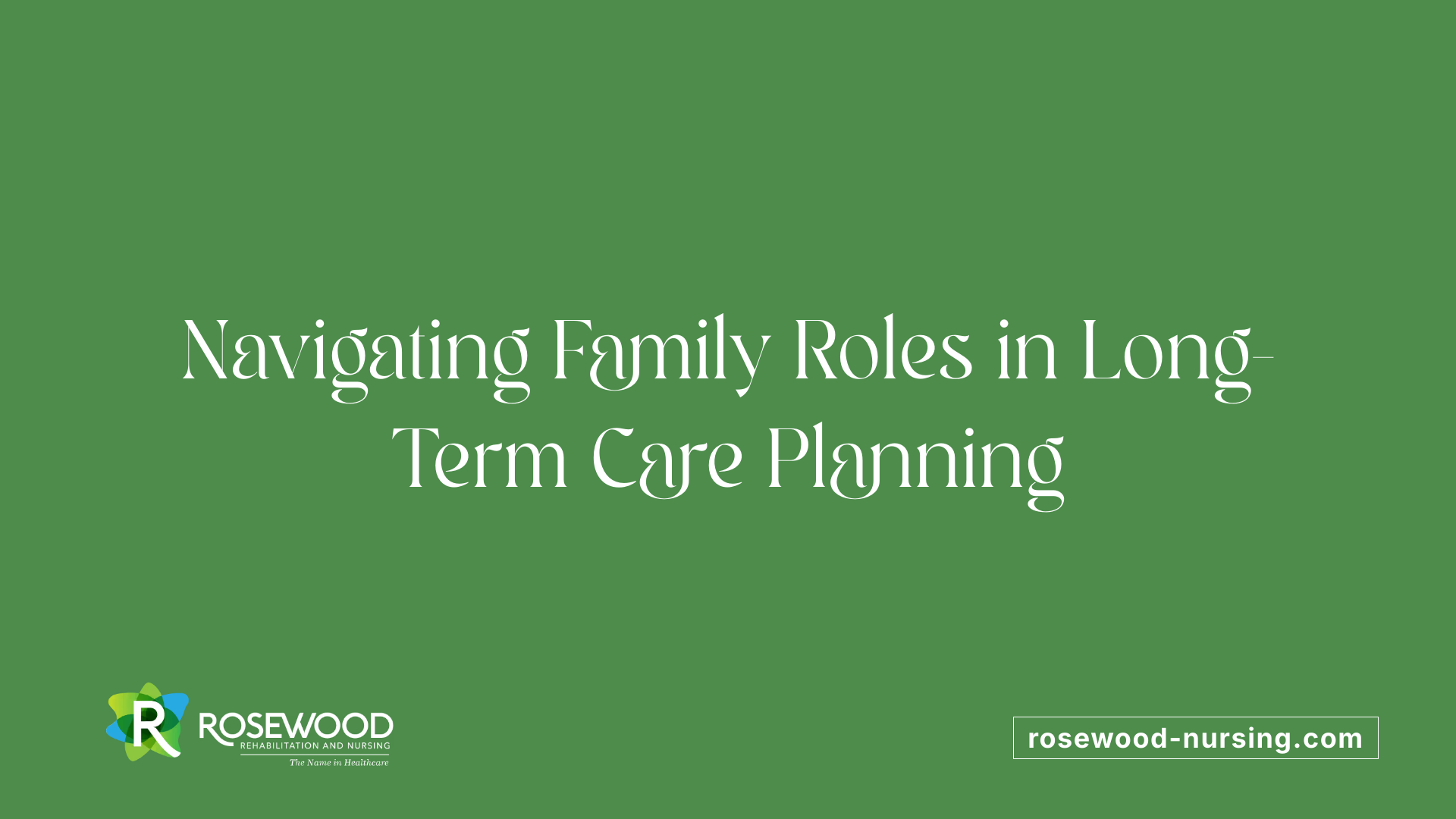How to Plan Financially for Long-Term Care Services
February 23, 2025
Navigating Financial Strategies for Long-Term Care Costs

Understanding the Long-Term Care Landscape
Long-term care planning is crucial for anyone approaching retirement age. With an estimated 70% of 65-year-olds likely needing some form of long-term care, individuals are compelled to prepare financially for these potential costs. This article provides a comprehensive guide to understanding and navigating the financial aspects of long-term care, covering everything from the types of facilities available to funding strategies without insurance.
The Essentials of Long-Term Care Facilities

What are the main types of long-term care facilities?
The main types of long-term care facilities include:
- Nursing Homes: Ideal for individuals requiring 24/7 medical care. These facilities cater to complex medical needs or chronic conditions that demand constant supervision.
- Assisted Living Facilities: These provide a blend of independence with support. Residents receive personal care services and can engage in social activities while living in a more independent environment.
- Continuing Care Retirement Communities (CCRCs): CCRCs offer a seamless transition through various levels of care, from independent living to assisted living and skilled nursing, all within a single facility.
Services provided by each type
| Type of Facility | Key Services Provided | Suitable For |
|---|---|---|
| Nursing Homes | 24-hour medical care, rehabilitation services, and support for chronic diseases. | Complex medical needs and post-operative recovery. |
| Assisted Living | Assistance with daily living activities, meal preparation, and social activities. | Seniors seeking more independence yet needing some assistance. |
| Continuing Care Retirement Communities (CCRCs) | Comprehensive care options that adapt to changing health needs, including personal assistance and skilled nursing. | Individuals looking for long-term security as their care needs evolve. |
Choosing the right facility based on needs
When selecting a facility, consider the individual’s health status, level of required assistance, and personal preferences. A nursing home might be best for those with serious health issues, while assisted living is suitable for those seeking more independence. CCRCs can offer a long-term solution as they provide various care levels in one location, catering to needs that may change over time. It's essential to evaluate the facilities’ environments, services offered, and potential costs to ensure the best fit for care requirements.
Funding Sources for Long-Term Care

What are the primary sources of financing for long-term care?
The primary sources of financing for long-term care include personal savings, insurance options, and government programs. Many older adults utilize personal funds such as savings, pensions, and proceeds from selling a home.
Given that standard health insurance typically does not cover long-term care costs, individuals need to strategize their finances for this potential expense. Key funding methods include:
- Personal Savings and Asset Liquidation: Many older adults pay for long-term care using out-of-pocket funds, including savings and proceeds from the sale of their homes. This self-funding approach can provide flexibility but may impact financial stability in retirement.
- Government Programs: Medicaid plays a crucial role in funding for those with low income who meet specific eligibility criteria, covering a significant portion of long-term care expenses, including nursing home costs. In contrast, Medicare offers limited support, primarily for skilled nursing facilities and certain medical costs following hospitalization, but does not cover most long-term care services.
- Insurance Options: Long-term care insurance can help offset the expenses associated with various types of care, such as in-home aides or assisted living. Additionally, hybrid policies combining life insurance and long-term care coverage may also be considered. Health savings accounts (HSAs) and reverse mortgages offer alternative means to fund long-term care, with unique benefits and restrictions.
Overall, individuals should explore a combination of personal assets, insurance policies, and government assistance to create a sustainable financial plan for potential long-term care needs.
| Funding Source | Description | Considerations |
|---|---|---|
| Personal Savings | Out-of-pocket funds, including savings and home sales | Offers flexibility but may deplete retirement funds. |
| Medicaid | Government assistance for low-income individuals | Requires strict eligibility criteria. |
| Medicare | Limited coverage for skilled nursing care | Does not cover most long-term care services. |
| Long-term Care Insurance | Policies covering various care expenses | Premiums can increase with age, best purchased earlier. |
| Hybrid Policies | Combine long-term care with life insurance | More complex, potentially higher costs for benefits. |
The Role of Long-Term Care Insurance

What role does long-term care insurance play in financing care?
Long-term care insurance plays a crucial role in financing care by covering the costs associated with various services needed for assistance with daily activities, such as home health care, assisted living, and nursing home care. Originally developed as nursing home insurance in the 1980s, it now encompasses a broader range of services.
This type of insurance is particularly important as nearly 70% of individuals turning 65 will require some form of long-term care in their lifetime, with average durations of care reaching around three years. Moreover, it helps alleviate the financial burden on personal savings and family, especially considering that Medicare has limited coverage for long-term care, primarily for skilled services following hospitalization.
Consumers should be well-informed about policy details, comparing options to find coverage that aligns with their needs and financial situation, including understanding tax implications and the financial stability of the insurer.
Benefits of long-term care insurance
- Financial Protection: It protects savings and assets by covering costs that would otherwise be out-of-pocket.
- Peace of Mind: Knowing there’s a plan in place reduces stress for individuals and families.
- Choice of Care: Many policies allow for flexibility in choosing care settings, whether at home, assisted living, or nursing facilities.
- Legacy Preservation: It helps ensure that assets can be passed to heirs rather than depleted by long-term care expenses.
How policies have evolved
- Broader Coverage: Initially focused on nursing home expenses, policies now cover a wide range of services, including in-home care and respite care.
- Hybrid Policies: The introduction of hybrid policies allows integration with life insurance or annuities, offering dual benefits and flexibility.
- Premium Adjustments: With rising healthcare costs, premiums have become more dynamic, often increasing as enrollees age, hence emphasizing the value of earlier purchasing.
Difference between standalone and hybrid policies
| Type of Policy | Description | Benefits |
|---|---|---|
| Standalone | Focuses solely on long-term care, covering various services for daily living support. | Clear coverage specifics, generally lower premiums than hybrids. |
| Hybrid | Combines long-term care insurance with life insurance or annuities, offering death benefits. | Flexibility and continued value even if care is not needed. |
Understanding these facets of long-term care insurance helps individuals make informed decisions, preparing for a secure financial future while addressing potential long-term care needs.
Strategies for Long-Term Care Preparation

What is an effective approach to planning for long-term care?
An effective approach to planning for long-term care involves several steps that can help individuals prepare for potential future needs. First, educate yourself about available options: whether it’s in-home care, assisted living, or nursing facilities. The costs can be significant; for example, the national median cost of a private nursing home room is approximately $108,405 annually.
Assessing your personal finances is crucial. Many adults find themselves unprepared for these expenses; troubling statistics reveal that only 28% of individuals aged 50-64 and 48% of those 65 and older have allocated funds specifically for long-term care. Therefore, exploring insurance options, including long-term care or hybrid policies, can mitigate financial burdens.
Budgeting and saving strategically is essential. Establish a dedicated long-term care savings account, taking into account average costs, which include $54,000 for assisted living and $61,776 annually for in-home health aides. This approach allows you to be financially prepared for potential needs.
Costs and considerations
The financial implications of long-term care can strain resources. For couples, planning must consider both partners potentially needing care at the same time. Individuals should also evaluate the type and duration of care needed, as many require care for three years, with some needing assistance for much longer.
Importance of family involvement
Involving family in the planning process is vital. Open communication can prevent rushed decisions during crises, allowing smoother transitions into care. Discussing preferences and potential resources available from family members can also significantly ease the financial and emotional burdens associated with long-term care.
Budgeting for Long-Term Care
How can you budget effectively for long-term care?
To budget effectively for long-term care, it's crucial to gather information about average costs in your local area. These can range widely based on the type of care needed and the location. For example, the current median annual costs can be approximately:
| Care Type | Median Annual Cost | Description |
|---|---|---|
| Home Health Aide | $75,000 | For in-home assistance with daily activities. |
| Assisted Living Facility | $64,200 | Offers housing and care support. |
| Private Nursing Home Room | $116,800 | The highest cost for nursing home care. |
What inflation considerations should you keep in mind?
Considering inflation is essential when planning for future healthcare costs. The annual rate of inflation for healthcare has historically increased, impacting the cost of long-term care. For instance, current yearly costs could double in approximately 20 years if average inflation trends continue.
How can insurance premiums fit into your budget?
Long-term care insurance can play a significant role in budgeting for these potential expenses. Premiums vary based on factors such as age, gender, and health conditions. For instance, a 55-year-old male might pay around $950 annually for a policy with $165,000 in benefits. In contrast, a single female might pay around $1,500.
Early purchase of a policy is advisable since premiums increase significantly with age, helping to alleviate financial pressure if care is needed later. Ensuring that your budget incorporates these insurance premiums will provide a safety net as you age.
Alternative Payment Strategies Without Insurance
What are some strategies for paying for long-term care without insurance?
Paying for long-term care without insurance can involve several strategies that focus on leveraging personal resources and government assistance. Many older adults rely on their personal assets, including savings, retirement funds, and even proceeds from selling a home to cover these significant expenses.
Utilizing Personal Assets: Individuals often turn to their savings and pensions when faced with long-term care needs. This approach can include liquidating investments or using retirement accounts. However, careful planning is necessary to avoid depleting funds intended for other retirement needs.
Reverse Mortgages and Annuities: For homeowners aged 62 and older, reverse mortgages provide a way to convert home equity into cash without the need for repayment until certain conditions are met. This can be an effective strategy to cover care costs, but it may affect estate planning. Additionally, annuities can provide steady payments that help cover long-term care expenses, though consulting a financial advisor is recommended to navigate tax implications.
Government Assistance Programs: Medicaid is a valuable resource for qualified low-income individuals to offset long-term care costs. However, to qualify, individuals must meet specific financial criteria, which often involve spending down assets to satisfy eligibility requirements. Furthermore, the specifics of Medicaid coverage can vary significantly by state, making it essential to research local guidelines.
Other strategies may include using life insurance policies with accelerated death benefits to help cover costs. Creating trusts can also aid in managing assets specifically designated for long-term care, offering better control over finances and potentially shielding them from unforeseen expenses.
These diverse strategies highlight the importance of planning for long-term care early, ensuring individuals and families are financially prepared when care is needed.
Social Security and Nursing Home Costs
How can one pay for nursing home care with Social Security?
Utilizing Social Security benefits can be an essential strategy for financing nursing home care; however, many discover that these benefits alone do not suffice. Current average costs for nursing homes range from $7,908 for a semi-private room to $9,034 for a private room each month. As of 2024, the average monthly Social Security benefit is estimated at about $1,700. This amount contributes only 21% of the cost of a semi-private room and a mere 18% toward a private room.
What is Supplemental Security Income?
Many seniors facing these expenses turn to Supplemental Security Income (SSI), a program designed to provide additional financial support to individuals with limited income. While SSI offers some help, it typically does not bridge the gap for the total cost of nursing home care. Consequently, older adults may still find themselves needing larger sums to cover essential services.
What is the role of federal assistance?
For those struggling to manage the remaining expenses, state or federal assistance programs like Medicaid become crucial. Medicaid provides comprehensive nursing home care for qualified individuals who meet specific low-income requirements. This assistance can significantly alleviate the financial burden many face. Overall, understanding and planning for these financial pathways is essential for securing the necessary resources for nursing home expenses, ensuring that individuals can access care without depleting their assets.
| Funding Option | Description | Suitability |
|---|---|---|
| Social Security Benefits | Monthly benefits to assist but generally insufficient for full coverage. | Limited income seniors |
| Supplemental Security Income (SSI) | Additional funds for low-income individuals, but still may not cover full costs. | Seniors with limited resources |
| Medicaid | Comprehensive coverage for nursing home care for qualified individuals. | Low-income individuals eligible for assistance. |
Long-Term Care and Family Dynamics

Role of Family Caregivers
Family members often play a pivotal role in long-term care, with about 70% of care provided by relatives or friends. This reliance can lead to significant emotional and financial challenges for caregivers, especially as the average duration of required care can reach three years, or even longer for some individuals.
Financial Implications
Funding long-term care can put a strain on family finances. Reports indicate that family caregivers may spend an average of $7,242 annually on care-related expenses, impacting their savings and retirement plans. Discussions about the division of caregiving responsibilities and expenses are essential to maintain balance.
Planning for Emotional Dynamics
It's crucial to address the emotional dynamics involved in long-term care planning. Open communication among family members about care needs, roles, and financial contributions can help mitigate stress and ensure everyone is on the same page. Establishing a written caregiving plan and discussing expectations can lead to improved outcomes for both caregivers and care recipients.
Final Thoughts on Financial Planning for Long-Term Care
Planning for long-term care is a multifaceted process requiring careful financial consideration and early preparation. From understanding the types of care available to considering various financial options, it is critical to personalize a strategy that fits your unique circumstances and future needs. By incorporating insurance, utilizing available resources like personal savings and government programs, and maintaining open dialogues with family, you can ensure a more secure and manageable transition into the long-term care phase of life. The financial and emotional aspects underscore the importance of these preparations for both individuals needing care and their families.
References
- Paying for Long-Term Care | National Institute on Aging
- Planning for Long-Term Care - Charles Schwab
- Planning for Long-Term Care: Costs, Insurance, and More
- Planning for long-term care - Vanguard sites
- How to plan for the cost of long-term care - Ameriprise Financial
- Long-Term Care Planning: Preparations and Considerations
- What Is Long-Term Care Planning? - SmartAsset
- Financial Considerations to Keep in Mind For Long Term Care
- Plan ahead for potential long-term care expenses
Similar articles

How Respite Care Improves the Quality of Life for Seniors and Caregivers

The Impact of Assisted Living vs. Nursing Home Care

Coping with Fatigue During Rehabilitation

Nursing Home Activities Participation Statistics

How to Identify the Best Nursing Home for Alzheimer’s Care

Contact us today and experience ”The Name in Healthcare”
Where compassion, well-being, and a welcoming community converge to redefine your healthcare journey. Welcome to Rosewood, where your family becomes our family.














